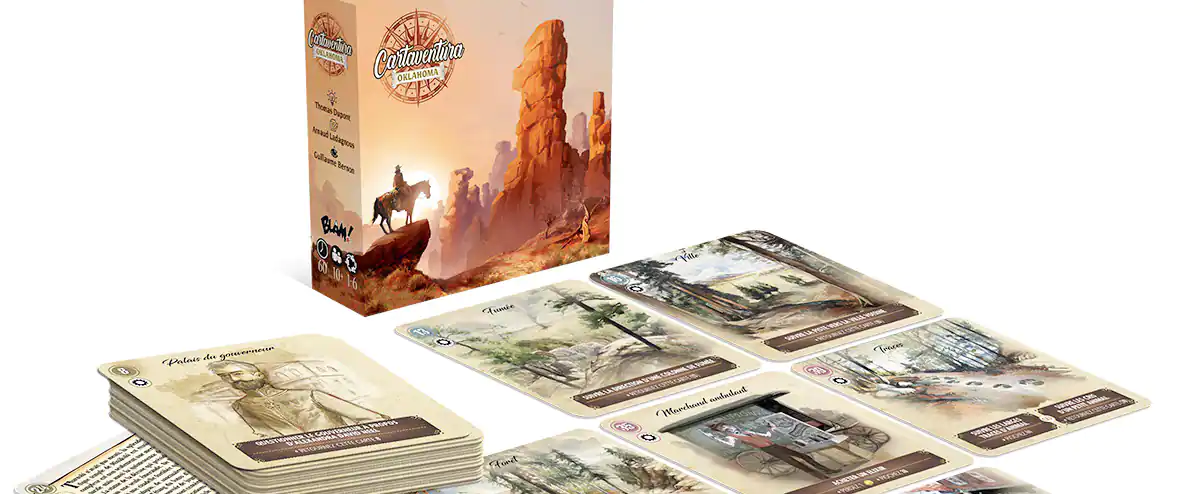Because we like to escape, we go on an adventure, whether in the jungle, in the West of the cowboys or on an island whose lush forest conceals intriguing ruins.
Cartaventura Oklahoma
- 1 to 6 players
- 10 years +
- 60 minutes
- $20.99
Here is a chic little box from a collection that currently includes three others.
This is a narrative game with five different outcomes depending on the decisions that will be made along the way.
First nice surprise, we open the box and we find a pack of beautiful square cards and no rulebook. What you need to know is written on the first card and you start playing immediately.
We let ourselves be guided by the game and the decisions we make over the cards that we reveal. These can be pieces of geographical maps, places or characters with whom we can choose to interact.
The storyline is very strong. In this box, we are interested in the life of Bass Reeves, the first black man to become a deputy sheriff with the US Marshalls west of the Mississippi. Yes, he really existed. And his path will notably cross that of Buffalo Bill in the game.
The cards are double-sided. Quite a brilliant trick of the game, some cards are locked (they have a small padlock) and over the games, by turning them over, they will be unlocked and it is in this order that they will return to the box at the end of the game . This means that the next time you play, the cards will not be quite the same.
You really get caught up in the story and the hour of play goes by very quickly because the players are discussing the decisions they are making as they go along.
And when you’ve found all five endings in a box, you’ll want to tackle the next ones, just like Unlock games do.
canopy
- 2 players
- 8 years +
- 30 minutes
- $33.99
Here is a game that will awaken your ecological conscience. Already, there is no plastic bag in the box. These are replaced by small paper bags.
In this game for two players, you must design the most lush forest possible while accommodating wildlife and vegetation that will change from season to season.
The game takes place over three seasons. On a small central board, there are three growth positions where cards are placed face down. On their turn, the player can look at the stack of their choice. If he does not keep it, he places a new card from the draw pile and looks at another until he makes his choice, without however being able to go back and take a pile that he has already consulted.
The chosen cards go to the player’s forest. He will be able to grow trees by laying trunks and top them with a canopy if he finds one.
The animals will remain in his play space throughout the game and some confer powers. The plants will be removed at the end of each season, as will the various plague (disease, forest fire) or weather (sun, rain) cards.
At the end of a season, players will count the points accumulated by flora and trees, with the player with the tallest tree in the season getting a bonus.
At the end of the game, whoever has the most trees in their forest will have a bonus of ten points.
There is a basic version and after a few games you can add cards that spice up the game, which we always like. A great success.
The Lost Ruins of Narak
- 1 to 4 players
- 14 years +
- 30 minutes per player
- $99.99
Before getting to the heart of the matter, let’s make one thing clear: it’s in the expert range of the Iello editor, but not because it’s difficult, only because there are a lot of possible options for playing a paying part.
In this game that combines worker placement and deck building (deck building), we are explorers who find themselves on a lost island.
Our objective is to discover temples by searching the game board because not all places will be accessible from the start, their discovery fits into the theme of the game. And the board is reversible, each side offering a different adventure.
It will be necessary to use its explorers well since they are limited and that the places offering resources are also limited in reception capacity.
The crux of the game lies in the decisions we make about the resources collected since these will allow us to carry out different actions.
Good planning will allow you to play longer in each of the five rounds of the game.
We can thus make cascading combinations if we play our cards well. Therefore, it is also a very computational experience and that is why it is categorized as an expert because otherwise it is possible to learn to play it in less than 15 minutes if the we find ourselves with a player who knows the rules well.
Only small downside: there is a ton of material and just as many plastic bags, which makes the installation and the collection a bit tedious.





